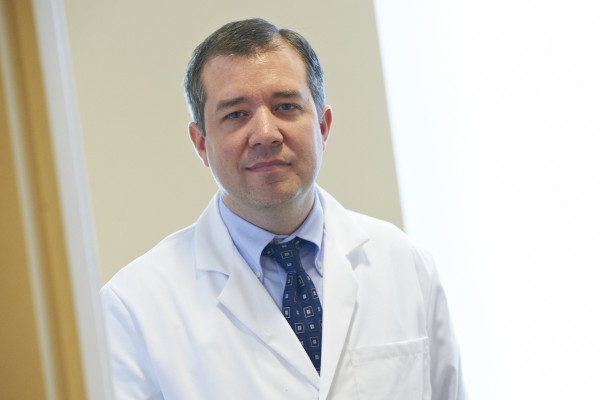Oncology
Non-Small Cell Lung Cancer
Precision Medicine in Patients With Non–Small Cell Lung Cancer and Rare Mutations
Overview
Next-generation sequencing early in the patient’s treatment course is important to broadly identify both common and rare oncogenic drivers of non–small cell lung cancer (NSCLC). When only 2 or 3 of the most common alterations are queried (eg, EGFR, ALK, and ROS1), then there is a risk of having to go back and test for the other alterations when the patient progresses, or when newer effective targeted treatments emerge for another oncogenic driver.
What is the recommended approach to testing for rare driver mutations?
Bruce E. Johnson, MD
|
|
“Rare cancers are important because we now find rare targetable mutations with the broad next-generation panels that have become widely available. Patients with cancer should get the testing done early in the treatment course.”
This is a topic of wide interest to the oncology community. Rare cancers are important because we now find rare targetable mutations with the broad next-generation panels that have become widely available. Patients with cancer should get the testing done early in the treatment course. Our major cancer organizations, both on the laboratory side and the clinical side, have advocated for broad panels for all of our patients with advanced cancer as soon as possible in their treatment course. Our institutions have these next-generation platforms available. The goal is to find out not only the common mutations that you could test for 1 at a time but also the rarer ones. One of the things we try to avoid is just getting the 2 or 3 most common alterations, such as EGFR, ALK, and ROS1 in patients with lung cancer, and then having to go back and test for the other alterations when the patient progresses. For example, NTRK alterations are only seen in approximately 0.3% of all lung cancers, but if you perform the testing early and know that the mutation is there, you can match up your targeted therapy with these rare mutations.
We do not want to have to test for each and every one of the mutations sequentially, or only very late in the disease course as a last-ditch effort. I believe that most of the potential targets have already been identified. The ongoing research will continue to find additional agents to target the oncogenic drivers that have already been identified. A good example is the KRAS G12C mutation; it was called “undruggable” in the past. We now have effective drugs available for that challenging oncogenic target.
Roy S. Herbst, MD, PhD
|
|
“If you are using a home-grown platform, you may not get all of the information you need on the first pass because the important genetic alterations are changing quickly. This can be a problem because there are places in the oncology community that do not have access to these broad next-generation sequencing platforms.”
If you are using a commercial next-generation sequencing platform, you usually get every oncogenetic alteration that has an effective targeted therapy because the platforms are constantly being updated. However, if you are using a home-grown platform, you may not get all of the information you need on the first pass because the important genetic alterations are changing quickly. This can be a problem because there are places in the oncology community that do not have access to these broad next-generation sequencing platforms. If you do not have the results up front, you may need to secure more tissue, send it out, and await the results. This process can cost you a couple of weeks.
Liquid biopsies have also changed the playing field, as you can get results within 4 or 5 days after drawing blood and sending the blood to the laboratory. The issue with plasma testing of circulating-free DNA is sensitivity. Although sensitivity with plasma testing is improving, it is still not as good as tissue biopsies in most cases. However, in some instances, it can be better than tissue because the site of the biopsy may not have the mutation of interest but the circulating-free DNA may have a detectable mutation shed by another site of involvement that was not biopsied. Sometimes, we will consider repurposing a drug that is US Food and Drug Administration approved for another tumor type if we find a genetic alteration for which there is evidence of efficacy in another tumor type. However, the mere presence of a mutation does not mean that the alteration is an oncogenic driver that can be effectively targeted. A mutation can be susceptible to a targeted therapy in one tumor type vs another. For example, BRAF V600E mutations can be effectively targeted with dabrafenib plus trametinib, while the combination is not effective as a doublet in colon cancer.
Gregory J. Riely, MD, PhD
|
|
“I think that it is important to emphasize that the driver oncogene status, in almost all patients with NSCLC, is the same at diagnosis as it is after first-line and second-line therapy. The exception is those patients who develop additional genomic changes that generate new mechanisms of resistance after being treated with targeted therapies.”
I think that one of the biggest challenges with rare driver mutations is related to genomic testing. You should perform testing in a next-generation sequencing platform that is comprehensive and that you believe will identify all of the genomic changes you need to treat your patients. I think that the best example of a rare driver oncogene in patients with NSCLC is probably alterations in NTRK, which are extraordinarily uncommon. They are seen approximately 0.3% of the time, as noted by Dr Johnson. These are technically difficult to identify, so you have to have a sequencing panel that you know will detect the NTRK rearrangements.
Further, the rarity of a mutation also translates clinically to having less experience with that particular targeted agent. You must be ready to identify a rare oncogenic driver mutation and then to write the prescription to act on it. This can be a challenge because you will be using a drug for which you are less familiar given that these are rare driver oncogenes, and these drugs can sometimes have unusual side effects. Overall, I think that it is important to emphasize that the driver oncogene status, in almost all patients with NSCLC, is the same at diagnosis as it is after first-line and second-line therapy. The exception is those patients who develop additional genomic changes that generate new mechanisms of resistance after being treated with targeted therapies.
References
Drilon A, Laetsch TW, Kummar S, et al. Efficacy of larotrectinib in TRK fusion-positive cancers in adults and children. N Engl J Med. 2018;378(8):731-739. doi:10.1056/NEJMoa1714448
Gkolfinopoulos S, Mountzios G. Beyond EGFR and ALK: targeting rare mutations in advanced non-small cell lung cancer. Ann Transl Med. 2018;6(8):142. doi:10.21037/atm.2018.04.28
Khunger A, Khunger M, Velcheti V. Dabrafenib in combination with trametinib in the treatment of patients with BRAF V600-positive advanced or metastatic non-small cell lung cancer: clinical evidence and experience. Ther Adv Respir Dis. 2018;12:1753466618767611. doi:10.1177/1753466618767611
Okamura R, Boichard A, Kato S, Sicklick JK, Bazhenova L, Kurzrock L. Analysis of NTRK alterations in pan-cancer adult and pediatric malignancies: implications for NTRK-targeted therapeutics. JCO Precis Oncol. 2018;2018:10.1200/PO.18.00183.-10.1200/PO.18.00183. doi:10.1200/PO.18.00183
Planchard D, Besse B, Groen HJM, et al. Dabrafenib plus trametinib in patients with previously treated BRAF(V600E)-mutant metastatic non-small cell lung cancer: an open-label, multicentre phase 2 trial. Lancet Oncol. 2016;17(7):984-993. doi:10.1016/S1470-2045(16)30146-2
Reck M, Rabe KF. Precision diagnosis and treatment for advanced non-small-cell lung cancer. N Engl J Med. 2017;377(9):849-861. doi:10.1056/NEJMra1703413













